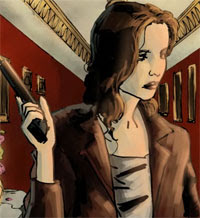
A few years back Konami released two very unique UMD’s for the PSP. These titles for Metal Gear and Silent Hill took the IGN comics and put them on disc, made them very interactive and offered up a unique concept to the gaming public. A success, not really, but worth mentioning when talking about the online graphic novel for The Prisoner. Written and produced by M. Scott Veach with art by Mitchell Breitweiser (Book 1) and Cliff Richards (Book 2), this offering is similar to the above mentioned UMD’s in it’s offering up of unique content tied to another medium. In the case of The Prisoner it’s the AMC miniseries.
I’m not going to try to recap the entire miniseries, just know this; the graphic novel takes place after the events on TV. If you are waiting to watch the series then don’t read the novel, and vice-versa, if you’ve watched the series then don’t wait, jump in and read the graphic novel. So how is it from a story and art standpoint, what about overall interaction? Let’s take a look.
Story – Knowing the mini-series will really help but overall those, like me, new to the franchise can still enjoy this tale. The first chapter does a good job setting the stage and the action begins right away. With all ten chapters already out there is no reason not to dive in and read. The back-story, full of spoilers for the miniseries, will really help before reading so weigh if this is worth ruining. I really like this avenue for rewarding fans of the series with more story that’s free. Similar to what SyFy did with Tokyopop and its Battlestar Galactica manga, not free, but a telling of content not seen in the series.
Art & Interaction – This is where The Prisoner shines. The style is very artistic with all settings and characters grounded in reality … in a sense. The detail is there but brought to life by paints, colors rather than detailed lines and pen/ink shading. This feels like the art see in various IDW novels, such as Metal Gear Solid, not as abstract but very close. Each chapter moves along with a ‘next’ button taking viewers to the next panel where the text appears in order and the action unfolds in appropriate movements based on the panel. Is a character walking, they don’t move their legs but rather slide across the screen. These movements take the still pictures of a comic and bring them to life without true animation. Like I said it’s an experience similar to those seen on UMD.
Bottom line, The Prisoner graphic novel expands on a decent story and uses an art style and interaction style that many video gamers will recognize. Having a free graphic novel online with this quality of art and storytelling is great. It’s not the first to pull this off, nor will it be the last. Check it out and maybe it peaks your interest in the series and gets you into or back into comics and graphic novels. They ain’t for kiddies folks.
I’m not going to try to recap the entire miniseries, just know this; the graphic novel takes place after the events on TV. If you are waiting to watch the series then don’t read the novel, and vice-versa, if you’ve watched the series then don’t wait, jump in and read the graphic novel. So how is it from a story and art standpoint, what about overall interaction? Let’s take a look.
Story – Knowing the mini-series will really help but overall those, like me, new to the franchise can still enjoy this tale. The first chapter does a good job setting the stage and the action begins right away. With all ten chapters already out there is no reason not to dive in and read. The back-story, full of spoilers for the miniseries, will really help before reading so weigh if this is worth ruining. I really like this avenue for rewarding fans of the series with more story that’s free. Similar to what SyFy did with Tokyopop and its Battlestar Galactica manga, not free, but a telling of content not seen in the series.
Art & Interaction – This is where The Prisoner shines. The style is very artistic with all settings and characters grounded in reality … in a sense. The detail is there but brought to life by paints, colors rather than detailed lines and pen/ink shading. This feels like the art see in various IDW novels, such as Metal Gear Solid, not as abstract but very close. Each chapter moves along with a ‘next’ button taking viewers to the next panel where the text appears in order and the action unfolds in appropriate movements based on the panel. Is a character walking, they don’t move their legs but rather slide across the screen. These movements take the still pictures of a comic and bring them to life without true animation. Like I said it’s an experience similar to those seen on UMD.
Bottom line, The Prisoner graphic novel expands on a decent story and uses an art style and interaction style that many video gamers will recognize. Having a free graphic novel online with this quality of art and storytelling is great. It’s not the first to pull this off, nor will it be the last. Check it out and maybe it peaks your interest in the series and gets you into or back into comics and graphic novels. They ain’t for kiddies folks.
